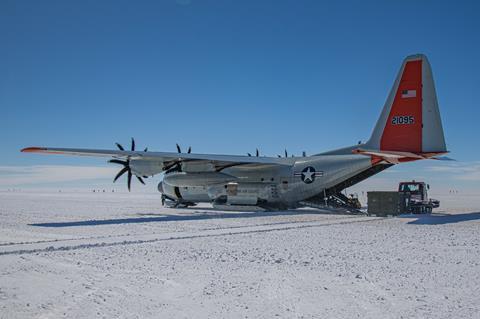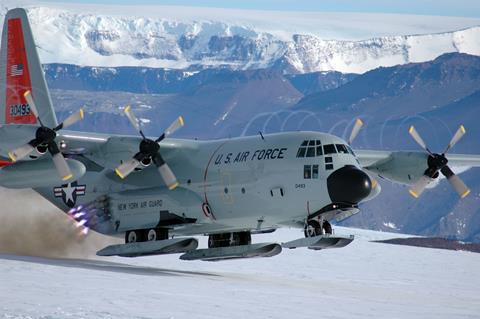Elected lawmakers in Washington are calling on the US Air Force to recapitalise the service’s fleet of ageing Lockheed Martin LC-130H Skibird polar transports.
The unique aircraft is equipped with specialised ski landing gear for take-off and landing on snow runways in the high latitudes. LC-130s are operated exclusively by the New York state Air National Guard (ANG) – a subcomponent of the US Air Force (USAF).
“The LC-130 is the centrepiece of US efforts to maintain a strategic advantage in polar theatres,” say senators Chuck Schumer and Kirsten Gillibrand, who represent New York state in the US Senate.
Only 10 operational LC-130s currently exist in the USAF fleet, all operated by New York’s 109th Airlift Wing. The specialised aircraft were first fielded to the unit in 1984.
Now, the two senators from New York – one of whom is the body’s current majority leader – are pushing the USAF to recapitalise the ageing Skibirds.
“As the only ski-equipped aircraft capable of operating in the Arctic and Antarctic environments, the LC-130 provides mission critical logistical support to regions that conventional aircraft cannot access,” the pair wrote in a 14 March letter to air force secretary Frank Kendall, the service’s top civilian official.
“As these planes approach the end of their service life, LC-130H operators and aircrew face a dangerous level of uncertainty during airlift missions,” the pair write. “This uncertainty jeopardises our ability to project power in the Arctic and Antarctic.”
In a 2022 interview with FlightGlobal, New York ANG commander Major General Denise Donnell said recapitalising the Skibird fleet was her top priority, shortly after she took charge of the unit.

Donnell’s crews are responsible for resupplying US and allied missions in Greenland and Antarctica, with a particular focus on scientific outposts. The specialised fleet also supports military missions, including US Northern Command’s annual Arctic exercises.
The current LC-130 fleet is based on Lockheed’s older H-model C-130 Hercules tactical transport. Schumer and Gillibrand are pushing the USAF to modernise the polar airlift mission with newer J-model C-130s.
“The majority of the existing LC-130H fleet were built in the 1970s,” the senators say, describing the four-engined transports as approaching the end of their service life.
There have been incremental improvements to the existing LC-130s over the years, including an improved Collins Aerospace NP2000 eight-bladed propeller system.
Designed specifically for the LC-130 Antarctica mission, the NP2000 offers up to 20% greater thrust during take off and a 50% reduction to maintenance hours, according to Collins.
The older four-bladed Hamilton Standard 54H60 propellers often required LC-130s to take-off over extremely long distances, making use of ground effect to achieve sufficient lift.
Donnell, herself a certified LC-130 pilot with three South Pole landings to her credit, told FlightGlobal about one 109th pilot who anecdotally took five miles to achieve lift off from a snow field.

Skibirds with the older four-bladed propeller system occasionally made use of an externally-mounted rocket-assisted propulsion system to overcome the excess drag.
Despite the periodic upgrades, Gillibrand and Schumer say the current LC-130s are “constantly suffering reliability issues and high maintenance costs”, and require full-scale replacement.
“With a mission capability rate of roughly 50%, it is apparent that modernisation efforts alone are not enough to secure the fleet’s long-term sustainability,” the senators argue.
The letter does not include a specific target for funding such an initiative.
Both Schumer and Gillibrand are powerful members of the Senate, which along with the House of Representatives approves all US government spending.
Schumer is currently the majority leader of the body, while Gillibrand sits on the armed services committee, which oversees military matters.
Under normal procedures, each military service sends a budget request to Congress for approval.



















